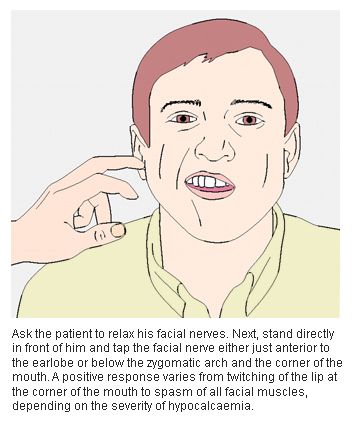Page Contents
- 1 WHAT IS IT?
- 2 WHY IS IT A PROBLEM?
- 3 WHAT MAKES US SUSPECT IT?
- 4 HOW DO WE CONFIRM A DIAGNOSIS?
- 5 HOW DO WE RULE OTHER DIAGNOSES OUT?
- 6 HOW DO WE TREAT IT?
- 7 HOW WELL DO THE PATIENTS DO?
- 8 WAS THERE A WAY TO PREVENT IT?
- 9 WHAT ELSE ARE WE WORRIED ABOUT?
- 10 OTHER HY FACTS?
- 11 ARCHIVE OF STANDARDIZED EXAM QUESTIONS
- 12 FURTHER READING
WHAT IS IT?
Hypoparathyroidism is a condition characterized by loss of activity of the parathyroid gland (parathyroid hormone/PTH decreased). This can be caused by a variety of things including:
- Accidental surgical excision of the glands
- DiGeroge syndrome
- Autoimmune destruction
Pseudohypoparathyroidism refers to a condition where the kidney is unresponsive to PTH
WHY IS IT A PROBLEM?
Decreased activity of the parathyroid gland (and PTH) will lead to decreased levels of serum calcium as well as tetany.
WHAT MAKES US SUSPECT IT?
Risk factors: DiGeorge syndrome, neck surgery, family history of hypoparathyroidism
May be asymptomatic and found incidentally
Generalized symptoms: fatigue and muscle ache
Chief complaints (associated with low calcium): numbness and tetany
Dermatological findings: that can include
- Loss of hair axillary or pubic hair
- Coarsening of body hair
- Xerotic eczema (dry itchy skin)
- Nail abnormalities (brittleness, ridging, etc)
HOW DO WE CONFIRM A DIAGNOSIS?
Serum values: decreased PTH and calcium
*Hypocalcemia may induce EKG findings (not diagnostic but consistent with the diagnosis)
- Prolongation of ST and QT intervals
- T-wave inversion
- Dysrhythmias
HOW DO WE RULE OTHER DIAGNOSES OUT?
Pseudohypoparathyroidism will be characterized by INCREASED PTH and decreased calcium.
HOW DO WE TREAT IT?
Supplementation with calcium and active vitamin D
Thiazide diuretics (hydrochlorothiazide) can be considered to limit calcium loss.
Calcium gluconate (IV) can be given in acute settings
HOW WELL DO THE PATIENTS DO?
The prognosis of this condition depends on the underlying condition
WAS THERE A WAY TO PREVENT IT?
Limiting surgical error can sometimes prevent iatrogenic hypoparathyroidism.
WHAT ELSE ARE WE WORRIED ABOUT?
DiGeroge Syndrome: is a congenital condition that presents with hypoparathyroidism (this could be the underlying cause of hypoparathyroidism in patients)
OTHER HY FACTS?
Pseudohypoparathyroidism can be an autosomal dominant condition (Albright hereditary osteodystrophy) that is associated with short stature and short 4th and 5th digits
ARCHIVE OF STANDARDIZED EXAM QUESTIONS
This archive compiles standardized exam questions that relate to this topic.
FURTHER READING
Page Updated: 02.10.2016

